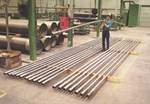Composite Drilling Risers Many Years In The Making
The development of rigid composite riser systems has a history that spans two decades. Beginning in 1979, Aerospatiale and the Institut Français du Pétrole (IFP) developed a 15,000 psi, 4 inch composite tubular. Although this project started out as a feasibility study, by the mid-1980s it had led to the manufa
The development of rigid composite riser systems has a history that spans two decades. Beginning in 1979, Aerospatiale and the Institut Français du Pétrole (IFP) developed a 15,000 psi, 4 inch composite tubular. Although this project started out as a feasibility study, by the mid-1980s it had led to the manufacture, installation, and testing of a half-dozen fiberglass and carbon fiber tubulars. The hybrid tubulars measured 49.2 ft/15m in length with a 4 inch/100 mm ID and were installed as choke and kill lines in a drilling riser on a rig for three projects in the North Sea. This installation developed an initial performance database. IFP later tested 40 carbon and glass fiber tubulars. These samples were subjected to burst, collapse, tension, bending, and fatigue tests. A year later, the IFP was among several sponsors of a joint industry project (JIP) that initiated proof-of-concept research into the development of a working composite production riser. This work resulted in the manufacture of eight risers with 9 inch ID. Of those, six were tested for bending, tensile fatigue, and burst pressure.
In 1988, this same group entered into another JIP to continue its research. This phase of the study included damage tolerance analysis, residual strength testing, overall durability, and cyclic tensile fatigue testing. A third JIP proposed actual testing of three composite joints in a nonworking riser system on Conoco’s Jolliet production platform — testing that, so far, has not been carried out. Aerospatiale joined Coflexip and Lincoln Composites in a 1993 JIP, to further design and evaluate production risers.
This early research raised serious interest in the composite riser design, as indicated by the launch of two development programs in 1995: a rigid composite production riser, initiated by Lincoln Composites, and a rigid drilling riser concept, jointly developed by Westinghouse Electric and ABB Vetco Gray. Both were sanctioned by the advanced technology program of the U.S. Department of Commerce National Institute of Standards and Technology (NIST). As a result of these programs, a number of projects — aimed at developing either a composite drilling riser or a hybrid riser system with composite components — have reached the field testing stage.
Related Content
-
PEEK vs. PEKK vs. PAEK and continuous compression molding
Suppliers of thermoplastics and carbon fiber chime in regarding PEEK vs. PEKK, and now PAEK, as well as in-situ consolidation — the supply chain for thermoplastic tape composites continues to evolve.
-
Jeep all-composite roof receivers achieve steel performance at low mass
Ultrashort carbon fiber/PPA replaces steel on rooftop brackets to hold Jeep soft tops, hardtops.
-
The potential for thermoplastic composite nacelles
Collins Aerospace draws on global team, decades of experience to demonstrate large, curved AFP and welded structures for the next generation of aircraft.












